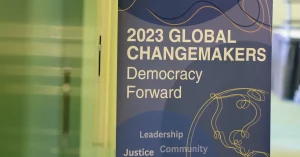REVIEW OF THE UNION BUDGET 2020
- The maths behind the headline fiscal deficit number
- Extra-Budget borrowing up, raising both transparency and concern
- A big jump in disinvestment target, making execution the key
- Banking on non-tax revenues again, but worrying drop in PSU dividends
- Tax initiatives: Away from exemptions, but dividend tax for recipients
- Concerns over defence, subsidies, tariffs and infrastructure spend
Overview
The Union Budget for 2020-21 was presented to Parliament on February 1, 2020 by Finance Minister Nirmala Sitharaman amidst the twin challenges of a slowing economy and fiscal slippages. India’s gross domestic product (GDP) growth was estimated at 5 per cent for 2019-20, compared to 6.8 per cent in 2018-19. Lower growth inevitably hurts government finances. The revenue projections for 2019-20 were made on the basis of nominal GDP growth of around 11 per cent. Instead, the actual nominal growth for the year was now close to 7.5 per cent.
As the government began preparations for its Budget for 2020-21, it quickly recognized how formidable were those challenges. If India’s economy had to be revived from the current slowdown, a slew of economic policy reforms was overdue. More importantly, the government had to seriously weigh the options of a fiscal stimulus which could quickly revive demand leading to higher growth.
But there were many questions. Were the government’s finances in good shape to take on the challenges of higher spending and a higher deficit? Would an increase in borrowing, caused by a higher deficit, raise interest rates, crowd out investments by the private sector and fuel inflation which had begun to grow? Ms Sitharaman’s second Budget was expected to resolve these dilemmas and face the economic challenges. How well has she fared in this exercise? Here is an assessment of her initiatives implicit in the Budget for 2020-21.
The maths behind the headline fiscal deficit number
As far as the headline fiscal deficit number is concerned, the Budget for 2020-21 showed the government’s resolve to adhere as close as possible to the fiscal consolidation path outlined in the Fiscal Responsibility and Budget Management Act. The 2019-20 trauma of overestimating the tax revenue projections, ignoring the implications of a slowing economy, and the dangers of exaggerating what could be plausibly realized through disinvestment hit the Budget makers hard. The Centre’s net tax revenues in 2019-20 fell short of the Budget Estimates made in July 2019 by as much as Rs 1.45 lakh crore. The shortfall in receipts from disinvestment was another Rs 40,000 crore. That was as large as Rs 1.85 lakh crore, or 0.9 per cent of the gross domestic product (GDP). This shortfall was made good by an additional receipt of Rs 36,000 crore of dividends and profits from public sector undertakings (PSU), state-controlled banks and the Reserve Bank of India (RBI). The government cut down its expenditure by a net amount of Rs 88,000 crore, almost 23 per cent of which came from unspent allocations under the Pradhan Mantri Kisan Samman Nidhi. The remaining gap of Rs 61,000 crore was met through additional borrowing, which raised the fiscal deficit number from 3.3 per cent to 3.8 per cent of GDP.
For 2020-21, the government has kept a check on its expenditure aspirations. At a total spend of Rs 30.42 lakh crore, it has projected an increase of just 12.7 per cent or Rs 3.44 lakh crore over the revised estimates for 2019-20. This extra expenditure is proposed to be more than made good by a whopping 223 per cent increase in disinvestment, an 8 per cent increase in net tax revenues and an 11 per cent increase in non-tax revenue – a total of Rs 3.15 lakh crore. Since the nominal size of the economy is expected to grow by 10 per cent in 2020-21, the higher base has allowed the government to show a lower fiscal deficit of 3.5 per cent of GDP. You may quarrel with the manner in which the estimates for revenue and expenditure have been made, but the government has on paper shown that it has stayed within the permissible fiscal deficit slippage of 0.5 per cent of GDP in a year. The earlier target for 2020-21 was 3 per cent. The trajectory of fiscal consolidation in the following two years has also been tweaked to project fiscal deficit at 3.3 per cent in 2021-22 and 3.1 per cent in 2022-23. But there is no significant or extra push towards more expenditure. Indeed, financial allocations for key schemes like the Mahatma National Rural Employment Guarantee Programme and National Health Mission have been reduced for next year. Also, meagre increases are shown for a host of other schemes like the Jal Jeevan Mission (a rise of just Rs 1,500 crore) and the allocation for PM Kisan has been retained at Rs 75,000 crore, the same amount that was allocated in 2019-20, of which only 72 percent could be spent this year.
Extra-Budget borrowing up, raising both transparency and concern
The tightfistedness of the government could be attributed to its realization that it was already in fiscally expansionary mode. This was because its extra-budget borrowings were already on the rise. Remember that the government in this budget displayed greater fiscal transparency by revealing upfront the extent and nature of extra-Budget borrowing it has incurred to reduce any further slippage in the headline fiscal deficit number. The practice of extra-Budget borrowing is not new. But the growing reliance on this has raised doubts about the integrity and quality of the fiscal consolidation programme. For instance, in 2019-20, the government sought recourse to extra-Budget borrowing of about Rs 1.73 lakh crore, of which about Rs 45,000 crore was raised through bonds fully serviced by the government and Rs 1.28 lakh crore was mobilised through loans from the National Small Savings Fund (NSSF). In 2020-21, the reliance on extra-Budget borrowing has gone up by 8 per cent to Rs 1.86 lakh crore, of which Rs 49,000 crore would come from government-serviced bonds and Rs 1.37 lakh crore from NSSF loan. If the government had not sought recourse to such extra-Budget borrowing, its fiscal deficit or the overall borrowing requirement would have shot up to 4.5 per cent of GDP for 2019-20 and 4.36 per cent in 2020-21. It is true that many other borrowings incurred by some statutory bodies are still not reflected in these numbers. But making such borrowings transparently public is a good move, to begin with. Going forward, why not also bring these borrowings on board and reflect them in the headline fiscal deficit number? Such borrowings also underline the fact that the government’s fiscal deficit was already high and there was little room to widen it further.
A big jump in disinvestment target, making execution the key
The centrepiece of the Budget is unquestionably the massive disinvestment programme the government intends to implement during 2020-21. It hopes to garner a total disinvestment receipt of Rs 2.10 lakh crore, of which Rs 1.2 lakh crore is slated to come from the sale of government equity in a host of PSUs and another Rs 90,000 crore from the sale of shares in public sector banks and financial institutions. The highlight of the proposed disinvestment programme will be an initial public offer (IPO) to be made by the state-owned insurance giant, Life Insurance Corporation of India. It is true that the government has lined up a long list of central PSUs for strategic sale of equity, including Air India, BPCL, Container Corporation of India, just to name a few. Add LIC and IDBI Bank to this list for 2020-21. Remember that the government’s track record in completing strategic sale of equity has been quite poor. Air India’s privatisation was planned in 2018, but it is still to be completed. The sale of BPCL was talked about early this year, but no indication of its timeline is out as yet. Not surprisingly, the government hopes to mobilise only Rs 65,000 crore in 2019-20 against a target of Rs 1.05 lakh crore. Given this unedifying track record on strategic sale of government equity in PSUs, the patchy state of the stock markets and the complex preparations required to launch an IPO of a company like the LIC, it is a big question mark if the huge target on disinvestment will be realized before 2020-21 closes. It is a critical element in the Budget, without fulfilling which the key numbers to ensure fiscal consolidation are likely to be missed.
Banking on non-tax revenues again, but worrying drop in PSU dividends
The Budget maintains the trend of a steadily growing share of non-tax revenues seen in the last few years. From about 9 per cent in the government’s total Budget size in 2017-18, the share of non-tax revenues went up to 10 per cent in 2018-19 and to 13 per cent in 2019-20. The Budget for 2020-21 projects that share to remain steady at 13 per cent or about Rs 3.85 lakh crore. On an annual basis, this is a rise of 11 per cent over 2019-20. However, there are worrying signals from the non-tax revenue numbers put out in the Budget. Non-tax revenues have two big categories: Other non-tax revenues and dividends/profits. Other non-tax revenues are composed largely of the general service fees and licensing income that the government gets from various services. Dividends and profits come from central PSUs, state-controlled banks/financial institutions and the RBI.
For next year, there is a sharp drop of about 22 per cent in the government’s non-tax revenue from dividends and profits to about Rs 1.55 lakh crore. This reflects the weakening state of finances of the central PSUs and the state-controlled banks. It also shows that after having garnered a total additional dividend and surplus capital of Rs 1.76 lakh crore from the RBI in 2019-20, the prospects of further revenues from the RBI will be limited next year. Similarly, other non-tax revenues are budgeted to grow by 64 per cent to Rs 2.15 lakh crore, but this gain is not sustainable. The sharp increase next year is largely due to an increase in the licence fees from the telecom companies, thanks to the Supreme Court verdict on what should constitute the telecom companies’ adjusted gross revenues to be shared with the Centre. As a result, the government’s income from other communication services will go up by 125 per cent from Rs 59,000 crore in 2019-20 to Rs 1.33 lakh crore. This growth too is not sustainable for the coming years. While non-tax revenues have helped the government’s overall finances next year, it has to look for newer ways to augment this stream by widening its scope and coverage.
Tax initiatives: Away from exemptions, but dividend tax for recipients
Budget 2020 will also be remembered for its tax initiatives. On the personal income-tax front, the government has proposed an alternative scheme for individuals to opt out of many of the exemptions they enjoy and pay tax at a lower rate. The full contours of the alternative scheme are still not clear. But this is a move in line with the government’s stated policy objective of moving away from an exemptions-based taxation regime. For the corporation tax rates as well, the government had announced last September that companies could opt for a lower tax rate provided they gave up all their exemptions. Now, individual tax payers get a similar option. Its popularity and acceptability among individual tax payers in the higher income brackets may be more and that perhaps explains the government’s estimate that it would forego tax revenue of about Rs 40,000 crore next year as a result of the proposed alternative tax regime for individuals.
However, the government may well compensate this revenue loss with the help of the proposed dividends distribution tax regime from next year. At present, companies paying out dividends are taxed at the rate of 15 per cent plus cess and surcharges. The proposed system envisages that individuals receiving dividend will be taxed at their respective applicable tax rates. In the earlier dividend taxation regime, the government got about Rs 41,000 crore from companies paying dividends in 2017-18. The new system would mean a big saving for companies. The government has actually budgeted for a revenue foregone amount of only Rs 25,000 crore next year. But since most individual tax payers enjoying dividend income fall in the higher income-tax slab of 30 per cent, it is likely that the government would receive more dividend tax than it receives now. Instead of receiving dividend tax at 15 per cent, the government may get the bulk of its dividend tax at the rate of 30 per cent.
The government has budgeted for a revenue loss of about Rs 65,000 crore from the two tax initiatives. But this loss estimate may well be exaggerated and there seems to be a cushion built within the revenue loss estimates. Remember that the government will also get some additional tax revenues with the help of its new tax dispute settlement scheme, announced in the Budget. There are over Rs 9.4 lakh crore of tax dues that are embroiled in disputes, of which Rs 4.9 lakh crore are on account of corporation tax dues and another Rs 4.5 lakh crore are on account of individual income-tax cases. Resolution of even a tiny portion of these disputed tax arrears could yield a big tax dividend for the government to boost its revenues. This will certainly help in a year when the government is expecting tax buoyancy to improve from 0.53 in 2019-20 to 1.2 in 2020-21. Achieving 12 per cent gross tax revenue growth can be a difficult exercise in a year when the nominal growth of the economy would be about 10 per cent. The task would have been easier but for the 15th Finance Commission’s recommendations, whose implementation next year would mean a sharp jump in the taxes to be transferred to the states by 18 per cent. Thus, the net tax revenues for the Centre is budgeted to grow by only 8 per cent, making the task of reining in the deficit a little more difficult.
Concerns over defence, subsidies, tariffs and infrastructure spend
Apart from the highly optimistic revenue projections, particularly on disinvestment, there are four other areas of concern over the Budget. The expenditure on defence has seen a small increase of about 2 per cent at Rs 3.23 lakh crore, excluding pension liabilities. This is too meagre an allocation for the country’s huge defence forces that require the support of a massive defence acquisition programme. Clearly, the first casualty of the government’s fiscal constraints has been the defence sector.
On the face of it, the government has reined in major subsidies, whose expenditure would be capped at Rs 2.8 lakh crore next year, compared to Rs 2.7 lakh crore in 2019-20. The marginal increase has been an outcome of a small cut in fertilizer subsidies and modest increases in food and petroleum subsidies. These numbers would underline the need for major subsidies reforms, without which these provisions would not be enough to meet the overall subsidies bill. Ideally, there is need to prune the petroleum subsidies bill, given the fall in the international crude oil prices. Also, the food subsidy bill rides heavily on the government increasing its loans from the NSSF to pay its subsidy-related bills to the Food Corporation of India. Sooner this practice is phased out, the better it will be for the government’s finances.
The rise of customs duty on 22 categories of items such as toys, footwear and walnuts is deeply worrying for an economy that wants to build on its domestic manufacturing capabilities. Building protectionist walls around Indian manufacturing can only undermine its competitiveness and work against the Make In India initiative of the government.
Equally worrying is the marginal increase of 2.4 per cent in the government’s total capital expenditure outlay including the internal and extra-Budget resources of public sector undertakings and the Indian Railways. At Rs 10.85 lakh crore, the figure reflects the weaknesses of the public sector entities in generating enough internal resources to meet the huge demands for higher investment in infrastructure. The saving grace is that the government’s own contribution to capital expenditure, by way of budgetary support, will go up by 18 per cent to Rs 4.12 lakh crore.

























